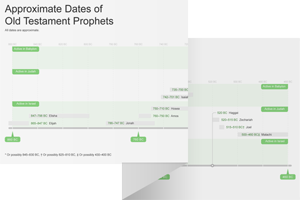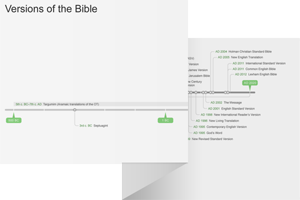1:1–3 The book of Ezekiel |
1:1 thirtieth year Date phrases usually originate from important events, such as the reference to the fifth year of Jehoiachin’s exile in Ezek 1:2. Since Ezekiel was a priest, the most likely explanation for the year reference is his 30th year of age, the time when a priest began official service in the temple (see Num 4:30).
fourth month, on the fifth The fourth month corresponds to late June and early July in the modern calendar. The year is the fifth year from King Jehoiachin’s exile, or 593 bc (Ezek 1:2).
 Israelite Calendar Table
Israelite Calendar Table
the Kebar River Ezekiel lived in a Jewish settlement near Nippur, east of Babylon. The Chebar (also rendered “Kebar”) was an aqueduct that diverted water from the Euphrates River through the city of Nippur. Two Babylonian tablets containing the name “Chebar canal” were unearthed in Nippur, establishing Ezekiel’s settlement in the vicinity.
(also rendered “Kebar”) was an aqueduct that diverted water from the Euphrates River through the city of Nippur. Two Babylonian tablets containing the name “Chebar canal” were unearthed in Nippur, establishing Ezekiel’s settlement in the vicinity.
The heavens were opened A common phrase in nt visionary texts, which were heavily influenced by Ezekiel’s visions (see Matt 3:16; John 1:51; Acts 7:56; 10:11; Rev 19:11).
 Prophetic Commissioning and the Divine Presence
Prophetic Commissioning and the Divine Presence
1:2 fifth year of the exile of Nebuchadnezzar, the crown prince of Babylon, took Jehoiachin and the leading officials of Judah into exile in 597 bc (see 2 Kgs 24:10–16). This vision would have occurred in 593 bc, prior to Nebuchadnezzar’s destruction of Jerusalem and the temple in 586 bc.
1:3 the word of Yahweh See note on Isa 1:10.
Ezekiel the son of Buzi, the priest Like Jeremiah, Ezekiel is among the priestly elite. His prophecies share many of a priest’s typical concerns, such as purity and holiness. Of all the prophets, Ezekiel has the closest literary affinity with the book of Leviticus. Most of Ezekiel is narrated in the first person, although Ezek 1:3 identifies the prophet in the third person.
the land of the Chaldeans The Hebrew text uses “Babylonians” and “Chaldeans” interchangeably. See note on Isa 43:14.
the hand of Yahweh Symbolizes a physical manifestation of His power and presence. Yahweh’s hand comes on the prophet Elijah giving him physical power to outrun King Ahab’s chariot in 1 Kgs 18:46. The phrase also describes the power of prophecy coming on the prophet Elisha in 2 Kgs 3:15. Ezekiel experiences the power of Yahweh’s hand (see Ezek 2:2, 9; 3:14; 8:3).
1:4–28 Unlike Isaiah, who seems to have encountered Yahweh in the Jerusalem temple (see Isa 6), Ezekiel is visited in Babylon by Yahweh’s chariot-throne. His description of the throne, heavenly beings, and the wheels transporting it likely reflects his own limited ability to describe what he saw; thus he uses metaphors and analogies. |
1:4 A storm wind was coming from the north A divine appearance or theophany was characterized by storm, wind, thunder, cloud, lightning, and earthquake imagery (compare Job 38:1).
 Theophany in the Old Testament
Theophany in the Old Testament
 Old Testament Theophanies Table
Old Testament Theophanies Table
amber stone Ezekiel is the only author to use the Hebrew word here, chashmal. The word is used here, in Ezek 1:27, and in 8:2. While the precise meaning of the word is obscure, context and etymology suggest it was a bright yellow substance, probably amber.
1:5 the likeness of The Hebrew word used here, demuth (which may be translated “likeness”), occurs 25 times in the ot—16 times in Ezekiel alone. Ezekiel uses this word 10 times in ch. 1 and 4 times in ch. 10 to describe the living beings and the divine chariot. Demuth denotes a simple comparison, and Ezekiel uses it to distance himself as he describes the indescribable divine manifestation.
four living creatures Ezekiel uses the nondescript Hebrew word chayyah for a living being here rather than a more specific term for heavenly beings such as keruvim (“cherubim”; see Gen 3:24 and note) or seraphim (see Isa 6:2 and note). The term emphasizes that Ezekiel is uncertain as to what he’s seeing, since chayyah most simply means “animate being.”
1:7 polished bronze Compare to the description of the Son of God with feet of burnished bronze in Rev 1:15; 2:18. Apocalyptic imagery in the books of Daniel and Revelation strongly echoes Ezekiel’s depictions.
1:9 their wings were touching one another Compare to the cherubim in Solomon’s temple. See 1 Kgs 6:27.
went straight forward Since the creatures have four faces, they can travel in any direction without turning.
1:11 and two covering their bodies The creatures covered themselves with wings just like the seraphim in Isa 6:2.
1:12 spirit The Hebrew word used here, ruach, seems to refer to an external spirit or force directing the movements of the living creatures. The word often refers to the Spirit of God and may refer to the empowering of the Holy Spirit, as in Ezek 3:12. Compare the spirit animating the wheels in v. 20.
1:13 appearance The Hebrew word used here, mar'eh, occurs seven times in this vision. The word denotes outward appearance but can also connote a pattern or image (Num 8:4). Here, the term parallels Ezekiel’s careful phrasing in Ezek 1:26, showing an intentional avoidance of concrete descriptions (see note on v. 5).
1:15 wheel Ezekiel’s description shifts from the living creatures in vv. 5–14 to the wheels next to the creatures in vv. 15–21. The wheels described here are more complex than simple chariot wheels (see note on v. 16).
1:16 the wheels Ezekiel uses ambiguous language in describing the wheels (called ophanim in Hebrew) just as he did in depicting the living creatures. The Hebrew word ophan is a term for a typical chariot wheel (see Exod 14:25).
like the appearance of beryl The wheels shine like a precious stone (called tarshish in Hebrew), but the precise identification of the stone is uncertain. Beryl, golden topaz, yellow jasper, and chrysolite are possible suggestions. The same word is used to describe a heavenly being in Dan 10:6.
a wheel within a wheel This phrase could refer to concentric circles (i.e., the hub to which the spokes attach in an ordinary wheel), but Ezekiel’s careful description seems to defy such a simple explanation. Another possibility is a gyroscope-like apparatus with wheels at right angles to one another. The latter option provides the possibility of multidirectional travel without turning.
1:18 full of eyes all around The eyes may be metaphors for lights or precious stones covering the wheels, or they may indicate literal eyes, suggesting the wheels themselves were living creatures. This interpretation likely influenced the later development of the ophannim into angelic beings (see note on Ezek 1:16). Compare John’s vision in Rev 4:6–8, where he describes the living creatures covered in eyes (see note on Rev 4:7).
1:20 the spirit Likely refers to whatever animating force is moving the wheels. See note on Ezek 1:12.
the spirit of the living creatures was in the The spirit was in the wheels (i.e., an animating force). The Hebrew uses the singular chayyah (“living thing”), just as wind or breath is the animating force in the creation of Adam (see Gen 2:7).
1:22 like the outward appearance of Ezekiel continues to use ambiguous language (see note on Ezek 1:5).
an expanse The Hebrew term used here is the same term used for the dome of the sky in Gen 1:6. This is an appropriate connection given that the expanse divided heaven and earth, with Yahweh dwelling above the expanse (see note on Gen 1:6–10).
ice Compare John’s vision in Rev 4:6 of a solid crystal surface before the divine throne.
1:24 the sound of many waters A roaring sound like rushing water accompanies Yahweh’s arrival (see Ezek 43:2). Compare the coming of the Son of Man in Rev 1:15.
Shaddai The Hebrew word used here, shadday, is a common name for God
is a common name for God (often rendered “Shaddai”) used most frequently in the books of Genesis (see Gen 17:1 and note) and Job (see Job 6:4). Ezekiel uses it only here and in the parallel passage in Ezek 10:5 to describe the sound of the divine chariot.
(often rendered “Shaddai”) used most frequently in the books of Genesis (see Gen 17:1 and note) and Job (see Job 6:4). Ezekiel uses it only here and in the parallel passage in Ezek 10:5 to describe the sound of the divine chariot.
1:26 the likeness of a throne See note on v. 5. Ezekiel uses “likeness” four times in vv. 26–28 alone.
looking like a sapphire See note on v. 13. Ezekiel is careful to liken what he sees to something recognizable. The descriptive Hebrew word used here, sappir, indicates sapphire stone or lapis lazuli, a bright blue semiprecious stone that was highly prized in the ancient world. Compare the sapphire pavement under God’s feet in Exod 24:10.
a likeness similar to the appearance of a human Ezekiel sees a figure that resembles a person, but he avoids saying that he sees a human being by using terms that convey likeness (see note on Ezek 1:5) and appearance (see note on v. 13) in his descriptions.
1:27 the likeness of his loins Ezekiel believes he sees the figure of a man with a waist, but he avoids stating so with certainty. Previous appearances of Yahweh in human form have been more subtle, such as His appearance to Abraham in Gen 18:1. Here, Yahweh’s human-like form is obscured by the brightness of His glory. Ezekiel encounters Yahweh again in this form in Ezek 8:2.
1:28 the appearance of a bow Compare Rev 4:3.
the likeness of the glory of Yahweh Ezekiel acknowledges that he’s been describing a vision of Yahweh in His glory (see note on Isa 6:3; compare Exod 16:7 and note; 16:10 and note).
I fell on my face He acts out of reverence and fear, a typical response in human encounters with the divine (see Ezek 3:23; 43:3; 44:4; compare Gen 17:3; Josh 5:14; Dan 8:17; Rev 1:17).

|
About Faithlife Study BibleFaithlife Study Bible (FSB) is your guide to the ancient world of the Old and New Testaments, with study notes and articles that draw from a wide range of academic research. FSB helps you learn how to think about interpretation methods and issues so that you can gain a deeper understanding of the text. |
| Copyright |
Copyright 2012 Logos Bible Software. |
| Support Info | fsb |
 Loading…
Loading…




